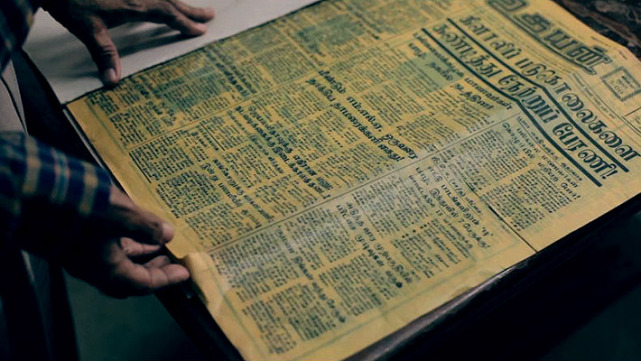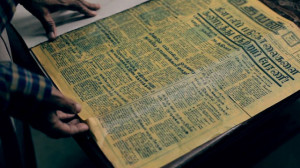Maneckshaw The first blow to a Jaffna newspaper was struck on the very night the Jaffna Public Library was set on fire in June 1981. Eelanadu, which was started in 1959 with veteran journalist K.P. Haran as Editor, was attacked by the same mob that had set the Jaffna Library aflame, completely destroying around 90,000 books and rare manuscripts. Christian missionaries, who had laid the foundation to institutionalize the educational system in Jaffna, were the pioneers of the first English and Tamil newspapers in the Peninsula. The first newspaper, the Morning Star, and its Tamil version Uthayatharakai were printed in 1841. The second English paper, known as the Jaffna Free Man was published in 1863. And this was followed by The Jaffna News in 1871 and the Catholic Guardian in 1876. The first Tamil newspaper to be published in the 20th century was the Suthesha Natyam in 1902. This was followed by the Eelakesari in 1930 and Eelanadu in 1959. The latter was published by late K.C. Thangaraja, an entrepreneur from Jaffna who successfully served as the Chairman of the Eastern Paper Mills in Valaichenai. The beginning of Eelanadu paved the way for a healthy newspaper culture in the Northern region, at is saw several veteran Tamil Journalists such as S.M. Gopalaratnam from Veerakesari and other Tamil newspapers published in Colombo giving up their lucrative journalistic career in the capital to join the Indian born late K.P. Haran. The journalists along with Haran, who was a former Editor of Veerakesari, gave their best to build Eelanadu into a powerful newspaper in the Peninsula, highlighting diverse views on the socio, political and the economic aspects of the Jaffna people. Eelanadu became a household name in Jaffna within a short period of its launch, and not long thereafter, the paper started spreading its wings to the Eastern Province. The Jaffna Tamils from Colombo too became regular subscribers of Eelanadu, appreciating its authentic contributions on Tamil affairs. However, with Tamil extremism gathering momentum in the early ’80s, Jaffna became a hotbed for newspapers and in no time, all the publications became popular as the hunger for news was immense, with political moves and militant activities taking place simultaneously. The popularity of the regional newspapers in Jaffna attracted several Jaffna youths who had dreamt of entering the universities and building careers in journalism. Several of them joined various publishing houses in Jaffna, showing great enthusiasm for the work. Even the graduates from the University of Jaffna, who looked forward to engage other professional jobs, had joined as journalists, strengthening the newspaper industry in Jaffna. Mainstream English publication Interestingly, the first mainstream English paper in Jaffna was the weekly, Saturday Review, published several years later, with veteran English journalist, late S. Sivanayagam, who was a contemporary of another veteran, Reggie Michael, as the Editor. Apart from the writers with a media background, university elitists such as Dr. Rajani Thiranagama, her academic sister, Nirmala Nithyananthan and others such as late A.S. Kanagaratnam who had also been a Daily News journalist in the ’60s, backed the Saturday Review and the publication instantly cultivated a larger readership not only in Jaffna, but in Colombo as well, with extensive contributions on the Tamil political scene of post-1983 communal disturbance. Sivanayagam returned to Colombo from the UK a few years ago and died shortly thereafter. When former Editor of the Sunday Observer, Ajith Samaranayake, passed away, Sivanayagam fondly remembered Ajith as saying he was the only Colombo-based journalist, who wrote in support of Sivanayagam, when he went through difficult times in Tamil Nadu. Two Tamil dailies, Murasoli and Eelamurasu, were bombed by the IPKF intelligence officials in the later part of 1987, as a warning to other media institutions in Jaffna, for their pro-LTTE stance. In the meantime, the LTTE having a former journalist in Anton Balasingham as its theoretician also put its iron fist into various newspapers in Jaffna. It also established its television station called Nitharsanam (Truth) in the Peninsula, airing its news stories on the offensives it had carried out and on its political stance. In the early ’90, following the closure of several Jaffna based newspapers, Uthayan became a formidable newspaper, and in the process became the target for attack by the various forces that objected to its stance. Over the years, the newspaper was attacked on more than 30 occasions and several of its journalists and media workers killed. The latest incident was the 3 April attack on the newspapers regional office in Kilinochchi. A recent study on media activities in Jaffna highlighted that more than 70 Tamil journalists and media workers from the North and East have been killed, with most of them being targeted in the North. Despite the attacks carried out on Jaffna-based media personnel and institutions, it is interesting to note that with the establishment of the Media Resources Training Centre (MRTC) in Jaffna, affiliated to the University of Jaffna, a large number of students have shown greater enthusiasm in joining the media fraternity in the North and some of them have already proved themselves as promising, not only in the print media, but even in the electronic media channels. It is indeed remarkable that despite the hostile environment for media in the North, Jaffna remains a powerful regional media hub in the country, with more than four publishing houses and tremendous enthusiasm from the younger generation. |

